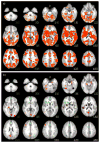Prediction of lithium response in first-episode mania using the LITHium Intelligent Agent (LITHIA): Pilot data and proof-of-concept
- PMID: 28574156
- PMCID: PMC5517343
- DOI: 10.1111/bdi.12507
Prediction of lithium response in first-episode mania using the LITHium Intelligent Agent (LITHIA): Pilot data and proof-of-concept
Abstract
Objectives: Individualized treatment for bipolar disorder based on neuroimaging treatment targets remains elusive. To address this shortcoming, we developed a linguistic machine learning system based on a cascading genetic fuzzy tree (GFT) design called the LITHium Intelligent Agent (LITHIA). Using multiple objectively defined functional magnetic resonance imaging (fMRI) and proton magnetic resonance spectroscopy (1 H-MRS) inputs, we tested whether LITHIA could accurately predict the lithium response in participants with first-episode bipolar mania.
Methods: We identified 20 subjects with first-episode bipolar mania who received an adequate trial of lithium over 8 weeks and both fMRI and 1 H-MRS scans at baseline pre-treatment. We trained LITHIA using 18 1 H-MRS and 90 fMRI inputs over four training runs to classify treatment response and predict symptom reductions. Each training run contained a randomly selected 80% of the total sample and was followed by a 20% validation run. Over a different randomly selected distribution of the sample, we then compared LITHIA to eight common classification methods.
Results: LITHIA demonstrated nearly perfect classification accuracy and was able to predict post-treatment symptom reductions at 8 weeks with at least 88% accuracy in training and 80% accuracy in validation. Moreover, LITHIA exceeded the predictive capacity of the eight comparator methods and showed little tendency towards overfitting.
Conclusions: The results provided proof-of-concept that a novel GFT is capable of providing control to a multidimensional bioinformatics problem-namely, prediction of the lithium response-in a pilot data set. Future work on this, and similar machine learning systems, could help assign psychiatric treatments more efficiently, thereby optimizing outcomes and limiting unnecessary treatment.
Keywords: artificial intelligence; bipolar disorder; fMRI; fuzzy logic; genetic algorithm; lithium; machine learning; mania; region-of-interest; spectroscopy.
© 2017 John Wiley & Sons A/S. Published by John Wiley & Sons Ltd.
Conflict of interest statement
Dr. Strakowski serves as DSMB chair for Sunovion and a consultant to Roche and Procter and Gamble. Dr. Adler has received research support through the University of Cincinnati from Johnson & Johnson, Merck, Forest, Otsuka, Purdue, Takeda, Pfizer, Shire, Sunovion and SyneuRx. He is a consultant to Sunovion. Dr. DelBello receives research support from Otsuka, Lundbeck, Shire, Sunovion and Pfizer. She is a consultant to Pfizer, Lundbeck, Sunovion, Otsuka, Supernus, Janssen and Neuronetics. Dr. Ernest is CEO of Psibernetix, Inc. We do not believe any of these relationships influence the reported results, but we report them for transparency. The remaining authors declare no conflicts.
Figures


References
-
- Angst J, Gamma A, Benazzi F, Ajdacic V, Eich D, Rossler W. Toward a redefinition of subthreshold bipolarity: epidemiology and proposed criteria for bipolar-II, minor bipolar disorders and hypomania. J Affect Disord. 2003;73:133–146. - PubMed
-
- Judd LL, Akiskal HS. The prevalence and disability of bipolar spectrum disorders in the US population: re-analysis of the ECA database taking into account subthreshold cases. J Affect Disord. 2003;73:123–131. - PubMed
-
- Goodwin FK, Jamison KR. Manic-Depressive Illness: Bipolar Disorders and Recurrent Depression. 2. New York, NY: Oxford University Press; 2007.
-
- Swann AC, Bowden CL, Calabrese JR, Dilsaver SC, Morris DD. Differential effect of number of previous episodes of affective disorder on response to lithium or divalproex in acute mania. Am J Psychiatry. 1999;156:1264–1266. - PubMed
MeSH terms
Substances
Grants and funding
LinkOut - more resources
Full Text Sources
Other Literature Sources
Medical

